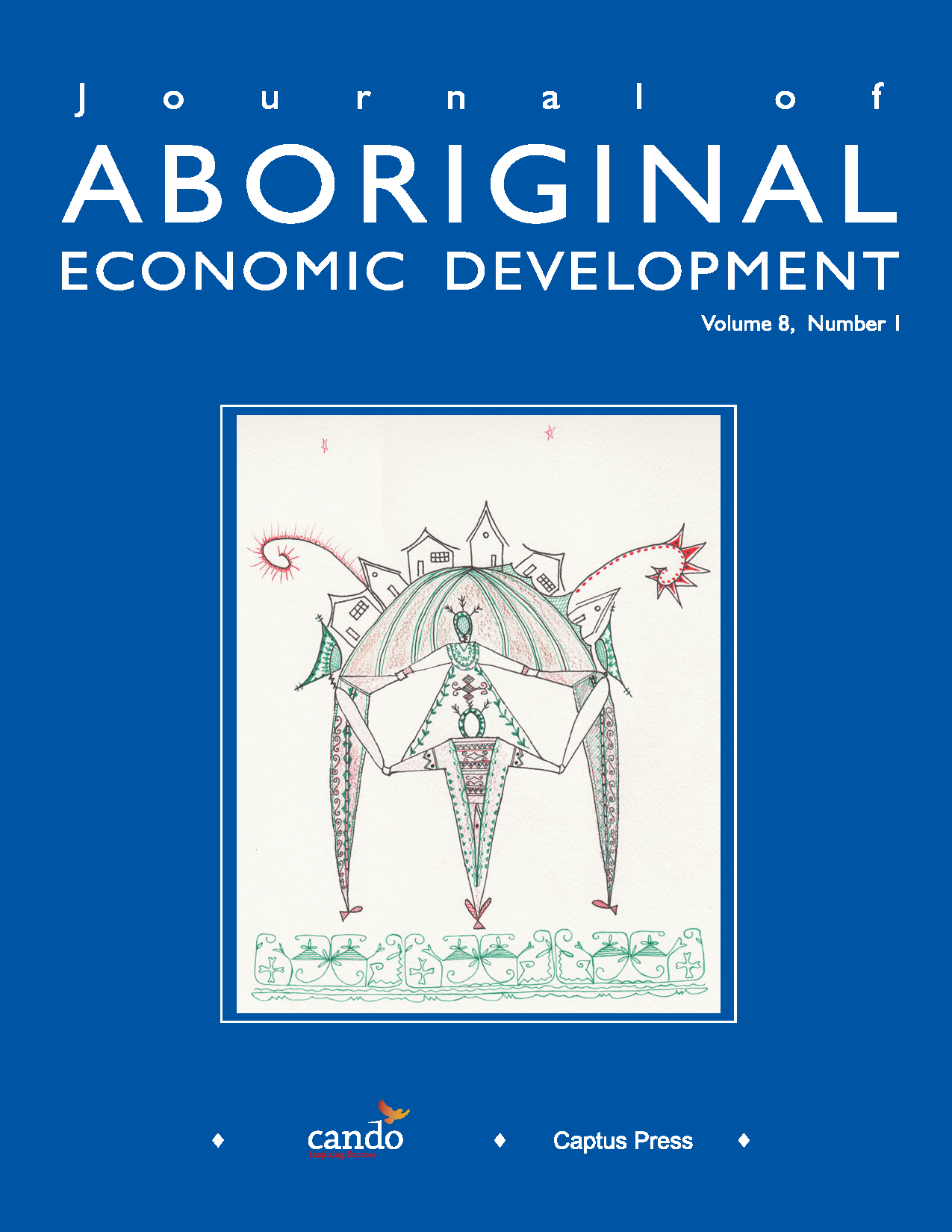Factors Influencing the Economic and Social Prosperity of Aboriginal Peoples
DOI:
https://doi.org/10.29173/jaed527Abstract
Numerous historical and current factors have combined to influence the economic and social prosperity of Aboriginal peoples. This paper reviews the contrary governmental and Aboriginal perspectives of the history of the last few hundred years and provides an overview of the current situation in Aboriginal communities in North America. This is followed by a discussion of economic and social development factors taken from qualitative and quantitative studies found in the literature. Conclusions and suggestions for future research are provided.
Downloads
References
ABC/INAC, C. (2008). Aboriginal business Canada. Retrieved March, 2008, from <http://www.ainc-inac.gc.ca/ps/abc/h_ab00070-eng.asp>
Ackerman, W.V., & Bunch, R.L. (2012). A comparative analysis of Indian gaming in the United States. American Indian Quarterly, 36(1), 50–74.
Anders, G.C. (1981). The reduction of a self-sufficient people to poverty and welfare dependence: An analysis of the causes of Cherokee Indian underdevelopment. American Journal of Economics & Sociology, 40(3), 225–237.
Anderson, R.B., Dana, L.P., & Dana, T.E. (2006). Indigenous land rights, entrepreneurship, and economic development in Canada: “Opting-in” to the global economy. Journal of World Business, 41(1), 45–55.
Bourguignon, F., & Morrisson, C. (1990). Income distribution development and foreign trade: a cross-sectional analysis. European Economic Review, 34(6), 1113–1132.
Bradbury, H., & Lichtenstein, B.M.B. (2000). Relationality in organizational research: Exploring the space between. Organization Science, 11(5), 551.
Briggs, J., & Sharp, J. (2004). Indigenous knowledges and development: A postcolonial caution. Third World Quarterly, 25(4), 661–676.
Caine, K.J., & Krogman, N. (2010). Powerful or just plain power-Full? A power analysis of impact and benefit agreements in Canada’s North. Organization and Environment, 23(1), 76–98.
Canada. (1996). Royal Commission on Aboriginal Peoples. bridging the cultural divide: A report on Aboriginal people and criminal justice in Canada. Ottawa: Ministry of Supply and Services Canada.
Cornell, S., & Kalt, J.P. (1990). Pathways from poverty: Economic development and institution-building on American Indian reservations. American Indian Culture and Research Journal Vol., 14, 89–125.
Cornell, S., & Kalt, J.P. (2000). Where’s the glue? institutional and cultural foundations of American Indian economic development. Journal of Socio-Economics, 29(5), 443.
Cornell, S., & Gil-Swedberg, M. C. (1995). Sociohistorical factors in institutional efficacy: Economic development in three American Indian. Economic Development & Cultural Change, 43(2), 239.
Dacks, G. (2004). Implementing first nations self-government in Yukon: Lessons for Canada. Canadian Journal of Political Science, 37(3), 671–694.
Deprez, P. (1971). The economic development of the Canadian north: With or without the Indians? Annals of Regional Science, 5(2), 8.
Deverteuil, G., & Wilson, K. (2010). Reconciling Indigenous need with the urban welfare state? Evidence of culturally-appropriate services and spaces for Aboriginals in Winnipeg, Canada. Geoform, 41(3), 498–507.
Dirthrower, A. (1972a). Nationalism. In R. Osborne (Ed.), Who is the chairman of this meeting? A collection of essays. Toronto, Ont.: Neewin.
Dirthrower, A. (1972b). The prophecy. In R. Osborne (Ed.), Who is the chairman of this meeting? A collection of essays. Toronto, Ont.: Neewin.
Dirthrower, A. (1972c). The white man’s rule. In R. Osborne (Ed.), Who is the chairman of this meeting? A collection of essays. Toronto, Ont.: Neewin.
Eversole, R. (2003). Managing the pitfalls of participatory development: Some insight from Australia. World Development, 31(5), 781.
Galbraith, C.S., & Stiles, C.H. (2003). Expectations of Indian reservation gaming: Entrepreneurial activity within a context of traditional land tenure and wealth acquisition. Journal of Developmental Entrepreneurship, 8(2), 93–111.
Gould, D.J., & Amaro-Reyes, J.A. (1983). The effects of corruption on administrative performance. World Bank Staff Working Paper 580. Washington: The World Bank.
INAC, C. (2008). First Nations People of Canada. Retrieved March, 2008, from <http://www.ainc-inac.gc.ca/ks/pdf/fnpc_e.pdf>.
Klitgaard, R. (1991). Gifts and bribes. In R. Zeckhauser (Ed.), Strategy and choice. Cambridge, MA: MIT Press.
Kuo, C.Y. (1976). The effect of education on the earnings of Indian, Eskimo, Métis, and white workers in the Mackenzie district of northern Canada. Economic Development & Cultural Change, 24(2), 387–398.
Kutzner, D., & Wright, P.A. (2010). An investigation into key market segments for Aboriginal tourism in northern British Columbia, Canada. Journal of Vacation Marketing, 16(2), 97–110.
Lamman, N., & Hallman, S.L. (1990). Inuvialuit economic outlook on the upswing. Transition, 3(12), 4.
Lee, T.W., Mitchell, T.R., & Sablynski, C.J. (1999). Qualitative research in organizational and vocational psychology, 1979–1999. Journal of Vocational Behavior, 55, 161–187.
Matthews, R., & Young, N. (2005). Development on the margin: Development orthodoxy and the success of Lax Kw’alaams, British Columbia. The Journal of Aboriginal Economic Development, 4(2), 100–108.
Mauro, P. (1993). Country risk and growth. Unpublished Manuscript, Department of Economics, Harvard University, Boston, MA.
McGregor, D. (2009). Aboriginal/non-Aboriginal relations and sustainable forest management in Canada: The influence of the Royal Commission on Aboriginal Peoples. Journal of Environmental Management, 92(2), 300–310.
Murphy, M.A. (2008). Representing Indigenous self-determination. University of Toronto Law Journal, 58(2), 185–216.
Newhouse, D. (1999). The development of the Aboriginal economy over the next 20 years. The Journal of Aboriginal Economic Development, 1(1), 68–77.
O’Hara, C.P. (1995). The impact of Indian gaming on a tribal economy and economic development strategy: The white.. Economic Development Review, 13(4), 12.
Owens, T., & Wood, A. (1995). Export-oriented industrialization through primary processing? IDS Working Paper 19, Institute of Development Studies. University of Sussex, Brighton.
Owers, R., & Weber, S.L. (1997). Strategic plan for southwest Indian community’s construction business. Journal of Construction Engineering & Management, 123(3), 331.
Pelletier (Wawashkesh), W. (1972a). Dumb Indian. In R. Osborne (Ed.), Who is the chairman of this meeting? A collection of essays. Toronto, Ont.: Neewin.
Pelletier (Wawashkesh), W. (1972b). Time. In R. Osborne (Ed.), Who is the chairman of this meeting? A collection of essays. Toronto, Ont.: Neewin.
Petten, C. (2007). Primrose Lake communities to get $15 million from feds. (cover story). Saskatchewan Sage, 11(5), 1–2.
Ponting, J.R., & Henderson, L.J. (2005). Contested visions of First Nation governance: Secondary analysis of federal government research on the opinions of on-reserve residents. Canadian Ethnic Studies, 37(1), 63–86.
Poole, T. (1972a). Conversations with north American Indians. In R. Osborne (Ed.), Who is the chairman of this meeting? A collection of essays. Toronto, Ont.: Neewin.
Poole, T. (1972b). A modern legend. In R. Osborne (Ed.), Who is the chairman of this meeting? A collection of essays. Toronto, Ont.: Neewin.
Quiñonez, C.R., & Lavoie, J.G. (2009). Existing on a boundary: The delivery of socially uninsured health services to Aboriginal groups in Canada. Humanity & Society, 33(1–2), 35–55.
Ranis, G., Stewart, F., & Ramirez, A. (2000). Economic growth and human development. World Development, 28(2), 197–219.
Richmond, C., Elliott, S.J., Matthews, R., & Elliott, B. (2005). The political ecology of health: Perceptions of environment, economy, health and well-being among `Namgis first nation. Health & Place, 11(4), 349–365.
Ross, R. (1992). Dancing with a ghost : Exploring Indian reality. Markham, Ont.: Octopus Publishing Group.
Ruffing, L.T. (1976). Navajo economic development subject to cultural constraints. Economic Development & Cultural Change, 24(3), 611.
Saku, J.C. (2002). Modern land claim agreements and northern Canadian Aboriginal communities. World Development, 30(1), 141.
Shleifer, A., & Vishny, R.W. (1993). Corruption. The Quarterly Journal of Economics, 108(3), 599–617.
Slowey, G.A. (2001). Globalization and self-government: Impacts and implications for first nations in Canada. American Review of Canadian Studies, 31(1), 265–281.
Smith, J. (1977). Creating jobs in an Indian community. Growth & Change, 8(4), 33.
Stabler, J.C. (1989). Dualism and development in the northwest territories. Economic Development & Cultural Change, 37(4), 805–839.
Todaro, M.P., & Smith S.C. (2009). Development Economics. Boston: Pearson Addison Wesley.
United Nations (1989). Corruption in government. New York: United Nations.
Vinje, D.L. (1996). Native American economic development on selected reservations: A comparative analysis. American Journal of Economics & Sociology, 55(4), 427.
Watson, J.G., & Rowe, C.D. (1976). Training of operative employees: Contributing to a successful native American enterprise: A case study by John G. Watson and Clair D. Rowe. Training & Development Journal, 30(4), 10–15.
Whiteman, G., & Cooper, W.H. (2000). Ecological embeddedness. Academy of Management Journal, 43(6), 1265–1282.
Wilkins, D.E. (1993). Modernization, colonialism, dependency: How appropriate are these models for providing an explanation of north American Indian ‘underdevelopment’? Ethnic & Racial Studies, 16(3), 390–419.
Wood, A. (1994). North-South trade, employment and inequality: Changing fortunes in a skill-driven world. IDS Development Studies Series. Oxford: Oxford University Press.
Wood, C. (1999). The Mississippi band of Choctaw Indians: A case study in economic development. Economic Development Review, 16(3), 99.
Zhou, A.W., Boshart, S., Seelisch, J., Eshaghian, R., McLeod, R., Nisker, J., Richmond, C.A.M., & Howard, J.M. (2012). Efficacy of a 3-hour Aboriginal health teaching in the medical curriculum: Are we changing student knowledge and attitudes? Health Education Journal, 71(2), 180–188.
Downloads
Published
Issue
Section
License
Copyright (c) 2012 Cando

This work is licensed under a Creative Commons Attribution-NonCommercial-NoDerivatives 4.0 International License.




